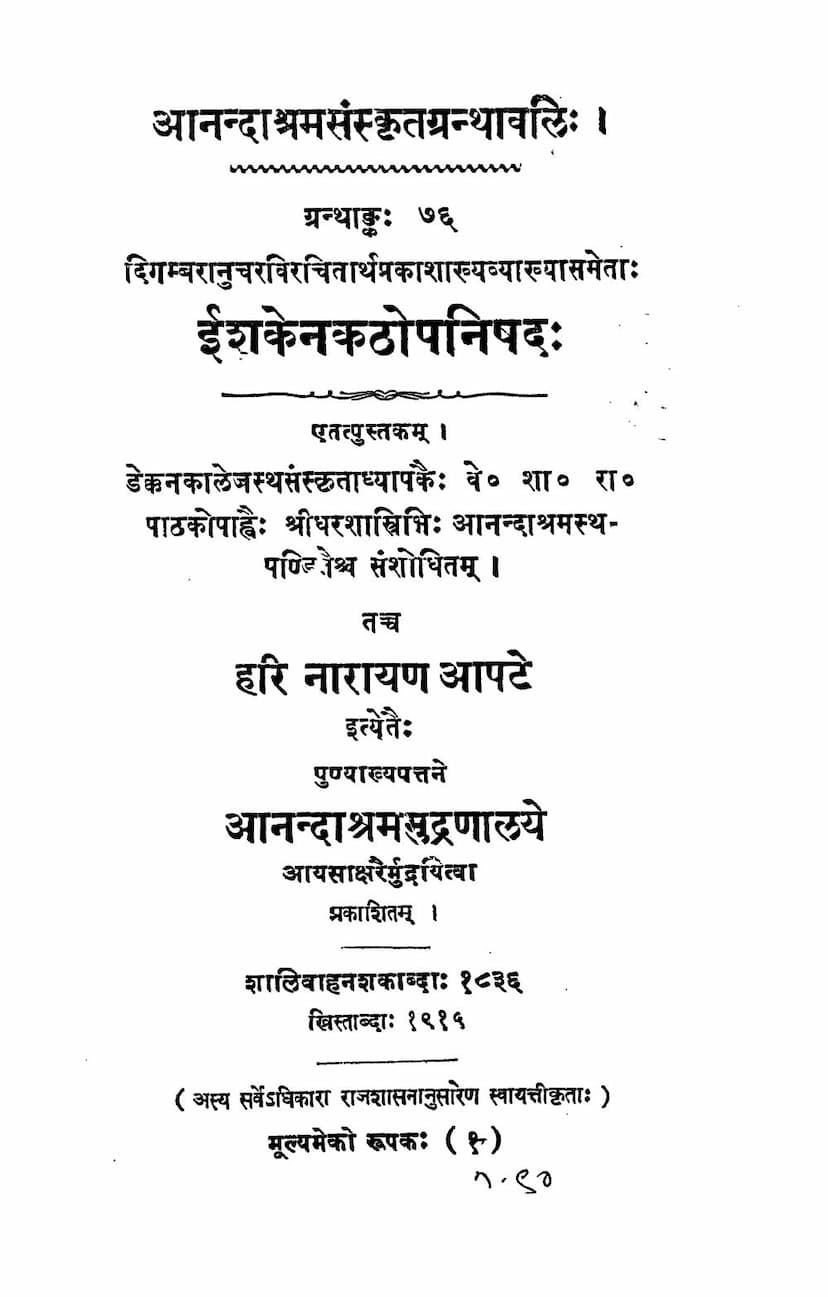Ishakenakathopnishad
Added to library: September 1, 2025

Summary
The book "Ishakenakathopnishad" by Hari Narayan Apte, published by Anandashram Mudranalay, contains a commentary titled "Arthaprakasha" by Digambaranuchara. The text comprises commentaries on two Upanishads: the Ishavasya Upanishad and the Katha Upanishad.
Ishavasya Upanishad Commentary:
The commentary begins by explaining the first verse of the Ishavasya Upanishad, "Īśā vāsyamidaṁ sarvaṁ yatkiñca jagatyāṁ jagat." It emphasizes that the entire universe, both moving and non-moving, is pervaded by the Divine (Isha). Therefore, one should renounce attachment and enjoy the world with detachment. The commentary delves into the concept of Brahman as the underlying reality of all existence, citing Vedic passages like "sarvaṁ khalvidaṁ brahma tadajjalāniti śānta upāsīta." It explains that understanding the origin and nature of sensory objects leads to the realization that they are ultimately Brahman. The essence of renunciation is the relinquishment of the sense of 'I' and 'mine,' achieved through knowledge and equanimity.
The text discusses the importance of performing actions while renouncing the fruits of those actions, drawing parallels with a lotus leaf remaining untouched by water. It advocates for living a full life dedicated to actions, yet with a detached mindset. The commentary also addresses the criticism of rituals and karma-kanda (ritualistic actions) as being merely temporary rafts leading to impermanent worlds, contrasting them with the eternal liberation achieved through knowledge. It clarifies the different types of renunciation (tyaga) – Sattvic, Rajasic, and Tamasic – emphasizing that true renunciation involves relinquishing the fruits of actions, not the actions themselves, and that performing prescribed duties without attachment is key to spiritual progress.
The commentary highlights the concept of Lokasangraha (welfare of the world), stating that even liberated beings should continue to act for the benefit of society. It then moves to the second verse, condemning those who worship ignorance and further condemning those engrossed in rituals without knowledge, leading them to darker realms. The text elaborates on the interconnectedness of actions and their consequences, defining karma as threefold: accumulated, ongoing, and to be performed. True liberation is achieved by transcending the cycle of karma, starting with the cessation of ongoing actions, followed by the dissolution of accumulated karma, and finally, the exhaustion of a portion of destined karma.
The commentary delves into the nature of Brahman as the unchanging, all-pervading, and subtle reality, beyond the comprehension of senses and mind. It quotes extensively from the Upanishads to illustrate Brahman's ineffable nature and the inadequacy of intellectual understanding alone. The path to realizing Brahman involves transcending duality and the limitations of the intellect.
The text further explains the concept of Anvaya (connection) and Vyativreka (disconnection) in understanding the Self. It describes the spiritual journey of realizing the Self as the underlying reality of all beings, leading to the transcendence of doubt, sorrow, and delusion. The ultimate goal is the realization of the non-dual nature of reality, where all beings are seen as the Self.
Katha Upanishad Commentary:
The Katha Upanishad portion begins with the narrative of Nachiketa, whose father, Vājashravasa, performs a Vedic sacrifice (Vishvajit) by donating all his possessions. Nachiketa, a young boy, observes the flawed nature of his father's sacrifice and the cows being offered, which are old and unproductive. Filled with faith, Nachiketa questions his father, leading to a pivotal moment where his father, in anger, declares he will give Nachiketa to Yama (the god of death).
The commentary details Nachiketa's three boons granted by Yama. The first boon is the pacification of his father's anger and the restoration of his peace of mind. The second boon is the knowledge of the fire sacrifice that leads to the celestial world, enabling the attainment of immortality. The commentary thoroughly explains the process and significance of this sacrifice, known as the Nachiketa Agni.
The third and most profound boon sought by Nachiketa is the knowledge of the true nature of the Self, particularly its state after death. Yama initially tries to dissuade Nachiketa from this quest, offering him worldly pleasures, long life, and celestial enjoyments instead. However, Nachiketa remains steadfast in his pursuit of ultimate knowledge.
The commentary then elaborates on Yama's explanation of the Self, using the famous analogy of the chariot. The body is the chariot, the senses are the horses, the mind is the reins, and the intellect is the charioteer. The Self, or the conscious subject, is the passenger. The commentary stresses the importance of controlling the mind and senses through the intellect to achieve the ultimate goal. It explains that a life driven by uncontrolled senses and a weak mind leads to a cycle of suffering and rebirth, while a disciplined life guided by wisdom leads to liberation.
The text emphasizes that the Self is not attainable through mere intellectual discourse, extensive learning, or ritualistic practices, but through the grace of a true Guru and unwavering devotion. It highlights the difficulty in comprehending the Self, which is subtler than the subtlest and vaster than the vastest. The commentary provides various analogies to illustrate the nature of the Self, such as the reflection in a mirror, the fire in firewood, and the sun pervading the universe.
The essence of the Katha Upanishad, as interpreted, is the realization of the Self through self-discipline, discrimination between the real and the unreal, and the guidance of a Guru. It underscores that this knowledge leads to the transcendence of death and the attainment of immortality. The commentary concludes by reiterating the significance of Nachiketa's quest and the profound teachings imparted by Yama, emphasizing that this knowledge, when understood and practiced, leads to ultimate liberation.